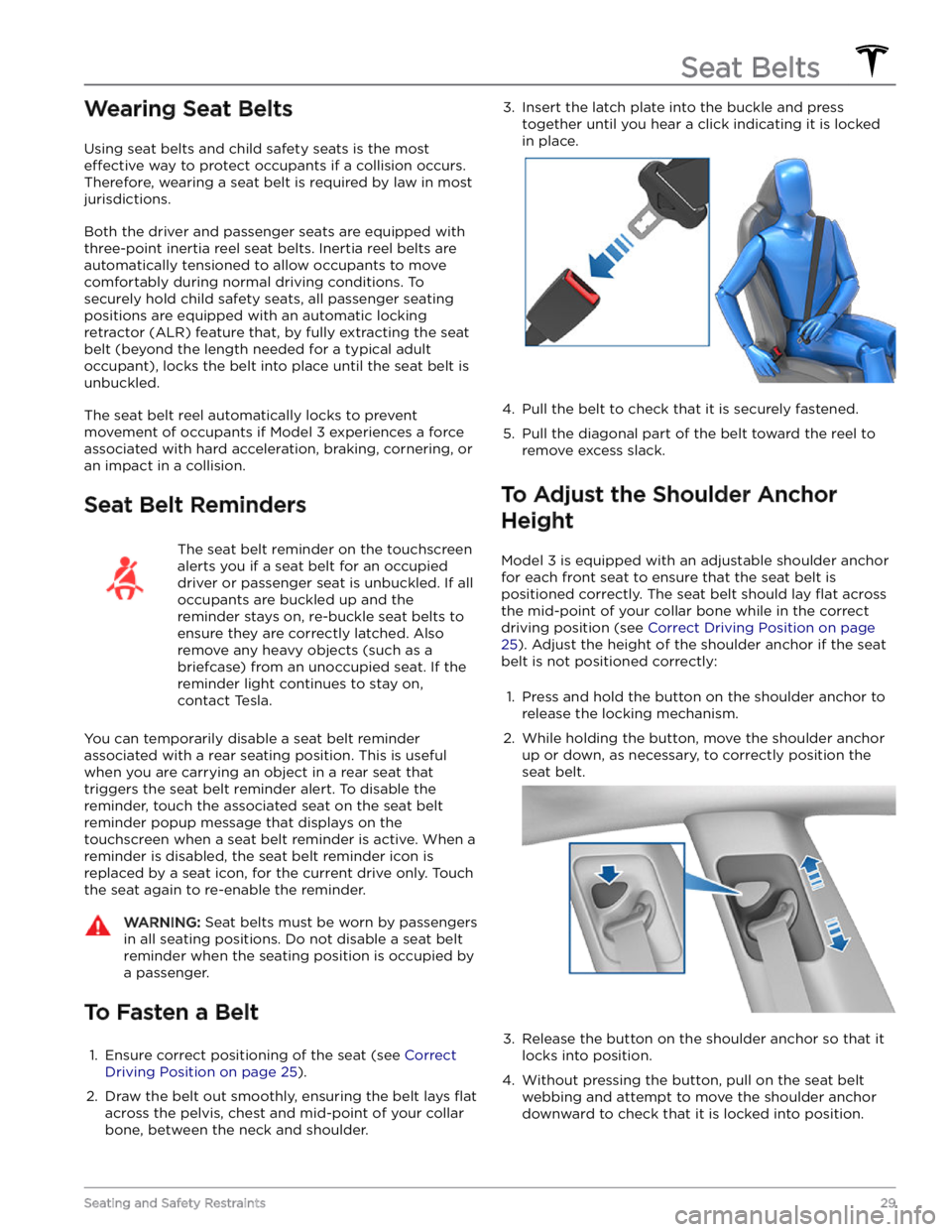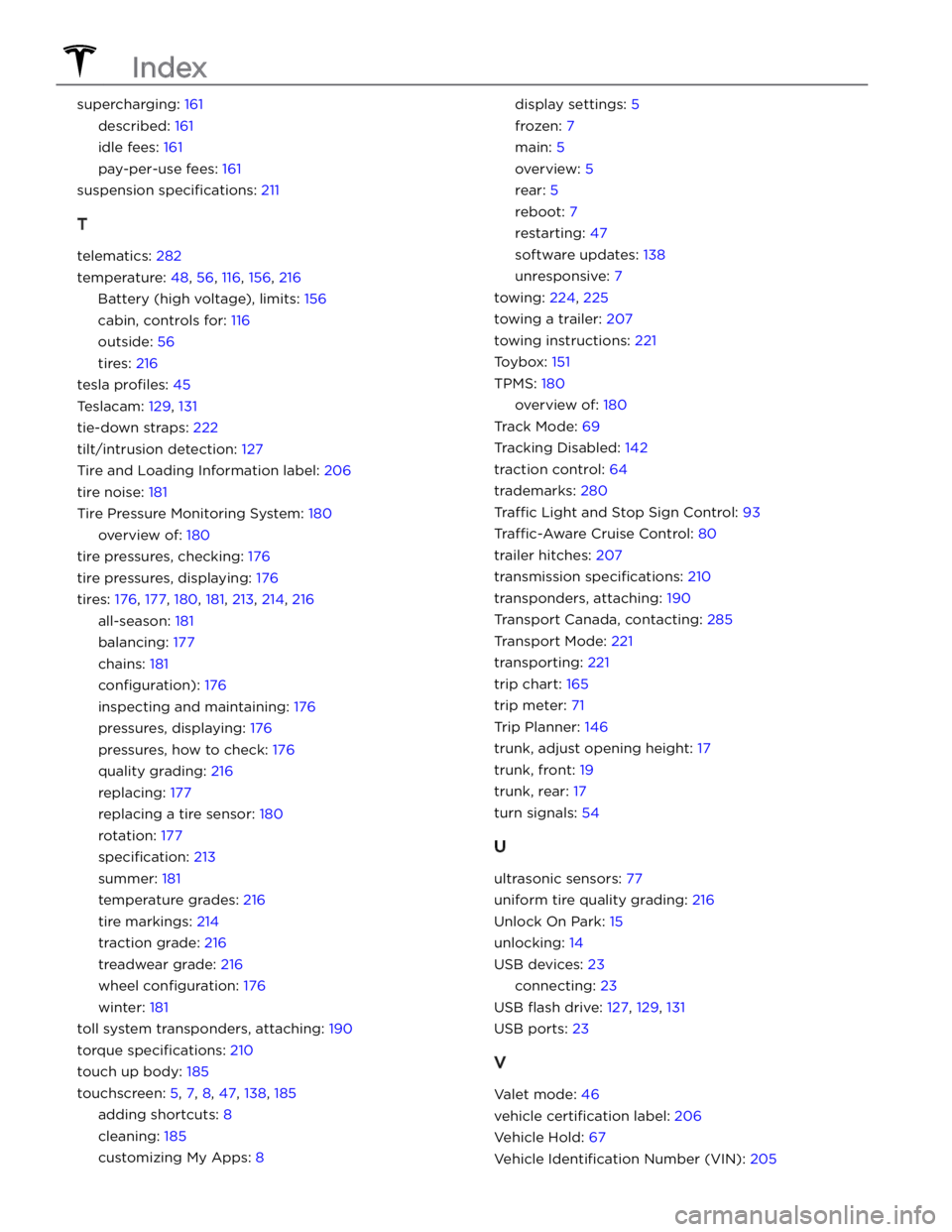height TESLA MODEL 3 2023 Owners Manual
[x] Cancel search | Manufacturer: TESLA, Model Year: 2023, Model line: MODEL 3, Model: TESLA MODEL 3 2023Pages: 296, PDF Size: 9.84 MB
Page 31 of 296

Wearing Seat Belts
Using seat belts and child safety seats is the most
effective way to protect occupants if a collision occurs.
Therefore, wearing a seat belt is required by law in most jurisdictions.
Both the driver and passenger seats are equipped with three-point inertia reel seat belts. Inertia reel belts are automatically tensioned to allow occupants to move
comfortably during normal driving conditions.
To
securely hold child safety seats, all passenger seating
positions are equipped with an automatic locking
retractor (ALR) feature that, by fully extracting the seat
belt (beyond the length needed for a typical adult
occupant), locks the belt into place until the seat belt is
unbuckled.
The seat belt reel automatically locks to prevent
movement of occupants if
Model 3 experiences a force
associated with hard acceleration, braking, cornering, or
an impact in a collision.
Seat Belt Reminders
The seat belt reminder on the touchscreen
alerts you if a seat belt for an occupied driver or passenger seat is unbuckled. If all
occupants are buckled up and the
reminder stays on, re-buckle seat belts to
ensure they are correctly latched. Also
remove any heavy objects (such as a
briefcase) from an unoccupied seat. If the
reminder light continues to stay on,
contact Tesla.
You can temporarily disable a seat belt reminder associated with a rear seating position. This is useful when you are carrying an object in a rear seat that
triggers the seat belt reminder alert. To disable the
reminder, touch the associated seat on the seat belt reminder popup message that displays on the touchscreen when a seat belt reminder is active. When a reminder is disabled, the seat belt reminder icon is replaced by a seat icon, for the current drive only. Touch the seat again to re-enable the reminder.
WARNING: Seat belts must be worn by passengers
in all seating positions. Do not disable a seat belt
reminder when the seating position is occupied by
a passenger.
To Fasten a Belt
1.
Ensure correct positioning of the seat (see Correct
Driving Position on page 25).
2.
Draw the belt out smoothly, ensuring the belt lays flat
across the pelvis, chest and mid-point of your collar
bone, between the neck and shoulder.
3. Insert the latch plate into the buckle and press
together until you hear a click indicating it is locked
in place.4.
Pull the belt to check that it is securely fastened.
5.
Pull the diagonal part of the belt toward the reel to
remove excess slack.
To Adjust the Shoulder Anchor
Height
Model 3 is equipped with an adjustable shoulder anchor
for each front seat to ensure that the seat belt is positioned correctly. The seat belt should lay
flat across
the mid-point of your collar bone while in the correct driving position
(see Correct Driving Position on page
25). Adjust the height of the shoulder anchor if the seat
belt is not positioned correctly:
1.
Press and hold the button on the shoulder anchor to release the locking mechanism.
2.
While holding the button, move the shoulder anchor up or down, as necessary, to correctly position the seat belt.
3.
Release the button on the shoulder anchor so that it
locks into position.
4.
Without pressing the button, pull on the seat belt webbing and attempt to move the shoulder anchor
downward to check that it is locked into position.
Seat Belts
29Seating and Safety Restraints
Page 191 of 296

Jacking Procedure
Follow the steps below to lift Model 3. Ensure that any
non-Tesla repair facility is aware of these lifting points.
1.
Position Model 3 centrally between the lift posts.
2.
Position the lift arm pads under the designated body lift points at the locations shown.
WARNING: DO NOT position the lift arm pads
under the Battery or side rails.
3.
Adjust the height and position of the lift arm pads to ensure that they are correctly located.
4.
With assistance, raise the lift to the desired height, ensuring the lift arm pads remain in their correct positions.
5.
Engage any lift safety locks. Follow the lift
manufacturer
Page 210 of 296

Exterior Dimensions
AOverall Length184.8 in4,694 mm
B
Overall Width (including mirrors)Overall Width (including folded mirrors)Overall Width (excluding mirrors)82.2 in 76.1 in
72.8 in2,088 mm 1,933 mm
1,849 mmCOverall Height56.8 in1,443 mm
DWheel Base113.2 in2,875 mmEOverhang - Front33 in841 mmFOverhang - Rear39 in978 mmGGround Clearance5.5 in140 mm
HTrack - Front
Track - Rear62.2 in
62.2 in1,580 mm
1,580 mm
*Values are approximate. Dimensions can vary depending on a vehicle
Page 216 of 296

Understanding Tire Markings
Laws require tire manufacturers to place standardized information on the sidewall of all tires. This information
identifies and describes the fundamental characteristics of the tire. It also provides the tire identification number
(TIN) for certification of safety standards, and in case of a recall.
1.
Tire category: P indicates that the tire is for passenger vehicles.
2.
Tire width: This 3-digit number is the width (in millimeters) of the tire from sidewall edge to sidewall edge.
3.
Aspect ratio: This 2-digit number is the sidewall height as a percentage of the tread width. So, if the tread width is
205 mm, and the aspect ratio is 50, the sidewall height is 102 mm.
4.
Tire construction: R indicates that the tire is of Radial ply construction.
5.
Wheel diameter: This 2-digit number is the diameter of the wheel rim in inches.
6.
Load index: This 2 or 3-digit number is the weight each tire can support. This number is not always shown.
7.
Speed rating: When stated, indicates the maximum speed (in mph) at which the tire can be used for extended
periods. Q=99 mph (160 km/h), R=106 mph (170 km/h), S=112 mph (180 km/h), T=118 mph (190 km/h), U=124 mph (200 km/h), H=130 mph (210 km/h), V=149 mph (240 km/h), W=168 mph (270 km/h), Y=186 mph (300 km/h),
(Y)=vehicle
Page 294 of 296

supercharging: 161
described: 161
idle fees: 161
pay-per-use fees: 161
suspension specifications: 211
T
telematics: 282
temperature: 48, 56, 116, 156, 216
Battery (high voltage), limits: 156
cabin, controls for: 116
outside: 56
tires: 216
tesla profiles: 45
Teslacam: 129, 131
tie-down straps: 222
tilt/intrusion detection: 127
Tire and Loading Information label: 206
tire noise: 181
Tire Pressure Monitoring System: 180
overview of: 180
tire pressures, checking: 176
tire pressures, displaying: 176
tires: 176, 177, 180, 181, 213, 214, 216
all-season: 181
balancing: 177
chains: 181
configuration): 176
inspecting and maintaining: 176
pressures, displaying: 176
pressures, how to check: 176
quality grading: 216
replacing: 177
replacing a tire sensor: 180
rotation: 177
specification: 213
summer: 181
temperature grades: 216
tire markings: 214
traction grade: 216
treadwear grade: 216
wheel configuration: 176
winter: 181
toll system transponders, attaching: 190
torque specifications: 210
touch up body: 185
touchscreen: 5, 7, 8, 47, 138, 185
adding shortcuts: 8
cleaning: 185
customizing My Apps: 8
display settings: 5
frozen: 7
main: 5
overview: 5
rear: 5
reboot: 7
restarting: 47
software updates: 138
unresponsive: 7
towing: 224, 225
towing a trailer: 207
towing instructions: 221
Toybox: 151
TPMS: 180
overview of: 180
Track Mode: 69
Tracking Disabled: 142
traction control: 64
trademarks: 280
Traffic Light and Stop Sign Control: 93
Traffic-Aware Cruise Control: 80
trailer hitches: 207
transmission specifications: 210
transponders, attaching: 190
Transport Canada, contacting: 285
Transport Mode: 221
transporting: 221
trip chart: 165
trip meter: 71
Trip Planner: 146
trunk, adjust opening height: 17
trunk, front: 19
trunk, rear: 17
turn signals: 54
U
ultrasonic sensors: 77
uniform tire quality grading: 216
Unlock On Park: 15
unlocking: 14
USB devices: 23
connecting: 23
USB flash drive: 127, 129, 131
USB ports: 23
V
Valet mode: 46
vehicle certification label: 206
Vehicle Hold: 67
Vehicle Identification Number (VIN): 205
Index